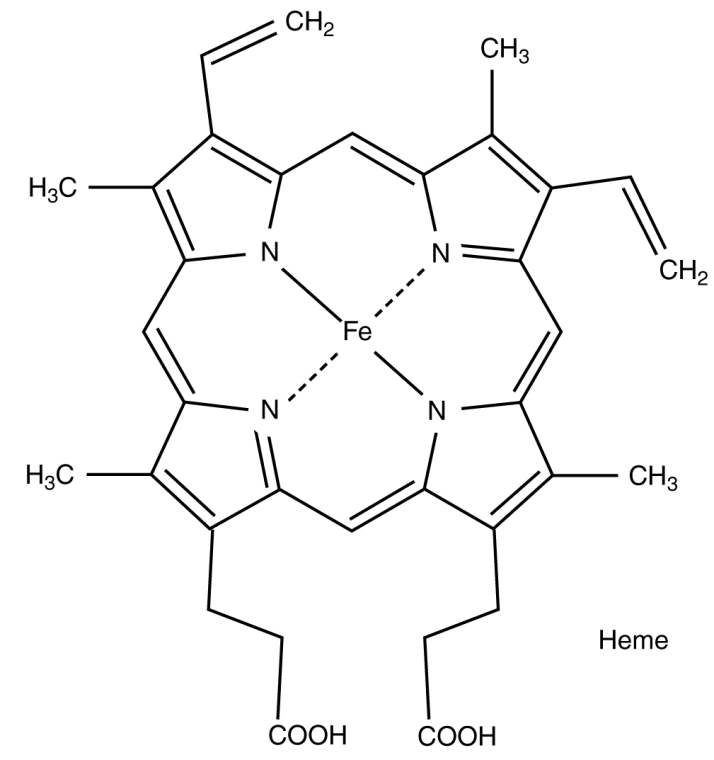
Due to which component, the colour of blood is red?
Answer
572.7k+ views
Hint: We can define the coordination complex as a compound that consists of a central atom (ion) that is metallic and is known as the coordination centre. It is surrounded by array bound molecules (or) ions called as ligands (or) complexing agents. Transition metals are coordination complexes. A coordination complex whose centre has a metal atom is known as a metal complex of d block element.
Complete step by step answer:
We know that the colour of blood is red. The component that is responsible for the red colour of blood is hemoglobin. Hemoglobin is present in red blood cells. Hemoglobin consists of four heme proteins combined with each other in a group. Hemoglobin is an iron-containing oxygen transport protein in red blood cells of all vertebrates. It has the capacity to bind with oxygen and gives red colour to the blood. Each subunit of hemoglobin is a globular protein with an embedded heme group.
We can draw the structure of heme as,

The heme attaches to the iron, oxygen then attaches to iron, and the interaction between the units of heme and oxygen gives red colour to blood.
Hemoglobin in blood transfers oxygen from the lungs or gills to other parts of the blood. In the blood, it liberates oxygen to allow aerobic respiration to give energy to power the role of the organism in the process known as metabolism. Twelve to twenty grams of hemoglobin is present in every 100mL of blood in a healthy person.
Note:
We have to know that hemoglobin is used in the transportation of other gases. It transports carbon dioxide as carbaminohemoglobin. In carbaminohemoglobin, carbon dioxide is attached to the protein of heme. We can also find hemoglobin outside red blood cells and their progenitor lines. Cells such as A9 dopaminergic neurons, macrophages, alveolar cells, hepatocytes, cervical cells and vaginal epithelial cells also contain hemoglobin in them
Complete step by step answer:
We know that the colour of blood is red. The component that is responsible for the red colour of blood is hemoglobin. Hemoglobin is present in red blood cells. Hemoglobin consists of four heme proteins combined with each other in a group. Hemoglobin is an iron-containing oxygen transport protein in red blood cells of all vertebrates. It has the capacity to bind with oxygen and gives red colour to the blood. Each subunit of hemoglobin is a globular protein with an embedded heme group.
We can draw the structure of heme as,

The heme attaches to the iron, oxygen then attaches to iron, and the interaction between the units of heme and oxygen gives red colour to blood.
Hemoglobin in blood transfers oxygen from the lungs or gills to other parts of the blood. In the blood, it liberates oxygen to allow aerobic respiration to give energy to power the role of the organism in the process known as metabolism. Twelve to twenty grams of hemoglobin is present in every 100mL of blood in a healthy person.
Note:
We have to know that hemoglobin is used in the transportation of other gases. It transports carbon dioxide as carbaminohemoglobin. In carbaminohemoglobin, carbon dioxide is attached to the protein of heme. We can also find hemoglobin outside red blood cells and their progenitor lines. Cells such as A9 dopaminergic neurons, macrophages, alveolar cells, hepatocytes, cervical cells and vaginal epithelial cells also contain hemoglobin in them
Recently Updated Pages
Master Class 12 Business Studies: Engaging Questions & Answers for Success

Master Class 12 Economics: Engaging Questions & Answers for Success

Master Class 12 English: Engaging Questions & Answers for Success

Master Class 12 Maths: Engaging Questions & Answers for Success

Master Class 12 Social Science: Engaging Questions & Answers for Success

Master Class 12 Chemistry: Engaging Questions & Answers for Success

Trending doubts
What is meant by exothermic and endothermic reactions class 11 chemistry CBSE

Which animal has three hearts class 11 biology CBSE

10 examples of friction in our daily life

One Metric ton is equal to kg A 10000 B 1000 C 100 class 11 physics CBSE

1 Quintal is equal to a 110 kg b 10 kg c 100kg d 1000 class 11 physics CBSE

Difference Between Prokaryotic Cells and Eukaryotic Cells




